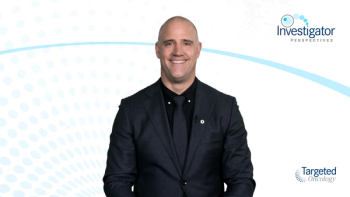
RR-DTC Systemic Therapy Considerations
Dr Andrew Gianoukakis, explores considerations surrounding systemic therapy in patients with RAI-refractory differentiated thyroid cancer.
Episodes in this series

Lori Wirth, MD: We are assuming that the patient does have established iodine-refractory disease. Andrew, would you recommend systemic therapy, beyond TSH [thyrotropin] suppression, at this point? Why or why not?
Andrew Gianoukakis, MD: At this point, the disease is clearly progressive. The volume of disease, however, is small. It’s important to look at the scans and identify the location of the lesions to rule out impending morbidity depending on the location of these lung lesions. All we know is that they’re in the lungs. If we’ve established that the patient is RAI [radioactive iodine]-refractory, we need to take a close look, and maybe not initiate therapy immediately, depending on some of this information, but we need to be putting our ducks in order, knowing what the molecular testing or the molecular characteristics of this tumor are, and considering systemic therapy sooner rather than later. Although, we have all seen papillary thyroid cancers and differentiated thyroid cancer progress, then quiesce and sit there for months or years, and then progress and maybe quiesce again. She’s clearly progressing now; I’d like to see that follow-up of thyroglobulin and another follow-up scan. I would like to know the location of the lesions; are we looking at mediastinal disease, paratracheal disease, disease that’s paraspinal? Or disease that is proximate to a main bronchus where small additional invasion can lead to morbidity? Or are we looking at this small-volume disease spread throughout the lungs, in the middle of the lung, and in a place where additional growth will not cause morbidity? If that is the case, again, I would want more follow-up information and to give the opportunity for the patients’ disease to attain stability before pulling the trigger on systemic therapy.
Marcia Brose, MD: You brought up a good point there, Andrew, because I just realized that we don’t really know if this patient has a disease elsewhere. While I don’t like to use PET [positron emission tomography] scans as a way to really follow people because the quality of the CT scan is really not that great, this is maybe a good opportunity just to do 1 PET scan, and to do an inventory to make sure that we don’t have lesions in femurs and various places as well that we would want to know about ahead of time.
Lori Wirth, MD: I think we need to move on. Andrew?
Andrew Gianoukakis, MD: I think maybe the only thing that we should answer is the why not.
Lori Wirth, MD: Why not?
Marcia Brose, MD: Go for it.
Andrew Gianoukakis, MD: Systemic therapy, with all its benefits, does have adverse effects that can significantly impact a patient’s quality of life. That is particularly true of lenvatinib and sorafenib, which up until recently were the only approved therapies. As Marcia mentioned, if patients do fall into a category of having one of the newer targetable mutations, that’s only about 10%, maybe 15% of patients, the therapies are associated with fewer adverse effects and similar efficacy. But one reason why not is that we would be exposing patients to potentially toxic therapies that will impact their quality of life. In addition, because these therapies do not cure disease but they control disease, we want to make sure that the patient is truly progressing and that we are really saving them from some morbidity if we are going to ask them to tolerate and deal with the potential impacts on quality of life.
This transcript has been edited for clarity.










































